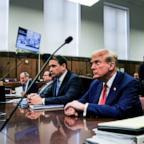A Dead Heat for Congress, Despite Clinton's Advantage (POLL)
Poll shows signs of vote splitting that could help down-ballot Republicans.
— -- Hillary Clinton’s lead in the presidential race is no longer in the double digits in the latest ABC News tracking poll, and there are signs of vote splitting that could help down-ballot Republicans.
Clinton leads Donald Trump, 49 to 40 percent, among likely voters. That’s not significantly different from her previous 50-38 lead, but it holds out the possibility of better days for Trump after his difficult last two weeks.
See PDF with full results here.
Moreover, likely voters divide almost evenly, 47 to 46 percent, between the Democratic and Republican candidates in their congressional district. While the measure’s imperfect (it is not limited to competitive districts and doesn’t cover Senate races), it indicates challenges for Clinton forces as they seek to turn her support into a broader Democratic wave.
Two key reasons emerge for the closer congressional contests in this poll, produced for ABC by Langer Research Associates. One is independent voters; the other is Republicans returning home for their local races:
• Independent likely voters divide evenly between Clinton and Trump, 41-41, in the latest tracking data. By contrast, independents favor the Republican over the Democrat in their congressional district, 51 to 39 percent.
• Trump wins 82 percent of Republicans in the presidential race, ceding 8 points to Clinton and 6 points to third-party candidates. In the congressional trial heat, however, 94 percent of Republicans stick with the GOP.
These results indicate the difficulties the Democrats face in turning a highly polarized electorate to their advantage, suggesting that Clinton’s lead in the presidential race relies primarily on the idiosyncrasies of that contest, not any broader realignment in political preferences.
That’s underscored by the fairly low level of strong enthusiasm for both candidates, given their unusual levels of personal unpopularity. Half of Trump’s supporters are very enthusiastic about their choice, as are 48 percent of Clinton’s. For comparison, Barack Obama and Mitt Romney both had 60 percent strong enthusiasm at this point in 2012, as did George W. Bush in 2004. It was even higher, 71 percent, for Obama at this stage in 2008.
Strong enthusiasm was as low as it is now or lower for some past candidates – 50 percent for John Kerry at this point in 2004, 39 percent for John McCain in 2008. Both, of course, lost to candidates whose support was more enthusiastic. It’s an advantage Trump held but then lost.
His strong enthusiasm fell 8 points, and overall enthusiasm among his supporters fell 12 points from late September to mid-October. Clinton’s strong enthusiasm subsequently rose, putting them at parity today.
Trends and 3rd Parties
The Clinton-Trump contest widened from a 4 point lead for Clinton in mid-October to a 12 point margin in the first two ABC News tracking poll horse race results. That followed a difficult period for Trump, in which a series of women accused him of sexual assault (which he has denied), he refused to say whether he will accept the legitimacy of the election if Clinton won and she was widely seen as having prevailed in their final debate.
Things have quieted a bit since, leaving open the questions of whether Trump can move away from the past two weeks and stage a recovery and whether Clinton, who carries substantial baggage of her own, can close the deal with her supporters. Crucial for both candidates at this stage is not so much changing minds but working on voter turnout.
The third-party candidates in the race, for their part, are not showing substantial impact. Gary Johnson of the Libertarian Party has 5 percent support overall, Jill Stein of the Green Party, 2 percent. They and other third-party candidates draw roughly evenly from Clinton and Trump supporters.
Specifically, when Johnson, Stein and other non-Clinton, non-Trump likely voters are asked to choose between the major-party candidates, 26 percent pick Clinton and 30 percent pick Trump. The plurality, 42 percent, say given just that choice, they wouldn’t vote for either one.
Groups
Basic contours of the race among groups are consistent. Clinton leads by 17 points among women, while men divide essentially evenly, 42 for Clinton and 45 percent for Trump. (Clinton was up 2 and 3 points versus Trump among men in previous tracking results — a first for her.) Trump leads by 7 points among whites, Clinton by 49 points among nonwhites.
Trump’s best group demographically remains white men who don’t have a four-year college degree, leading Clinton 61 to 29 percent. She counters with virtually the same advantage, 60 to 32 percent, among college-educated white women. That makes for a standoff, since both groups are essentially the same size, 17 and 16 percent of likely voters, respectively.
Clinton and Trump are running evenly among college-educated white men, 16 percent of the electorate. And a group of particular interest, given their changeability, is non-college-educated white women. They’ve ranged from up 7 to 37 points for Trump since July; currently they’re in the middle of that range, favoring Trump by 19 points, 56 to 37 percent. And they’re a slightly larger group, accounting for 23 percent of likely voters.
Methodology
This ABC News poll was conducted by landline and cellular telephone Oct. 21 to 24, 2016, in English and Spanish, among a random national sample of 1,119 likely voters. Results have a margin of sampling error of 3 points, including the design effect. Partisan divisions are 36-28-29 percent, Democrats-Republicans-independents.
Question 7 was asked Oct. 22 to 24 among 828 likely voters; those results have a 3.5 point error margin.
The survey was produced for ABC News by Langer Research Associates of New York City, with sampling, data collection and tabulation by Abt-SRBI of New York City. See details on the survey’s methodology here.




